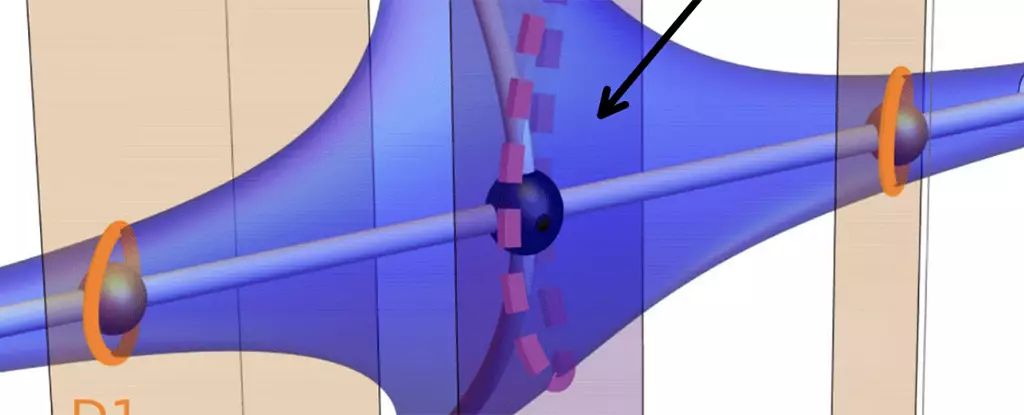The realm of condensed matter physics is known for its mystery and complexity, often yielding unexpected findings that challenge our understanding of the quantum world. Recent advancements have unveiled a quasiparticle that behaves unlike any known particle, exhibiting effective mass only when moving in a particular direction. This discovery, made by an international team of scientists, could pave the way for significant advancements in quantum physics and electronic sensor technology.
At the core of this discovery are quasiparticles—collective excitations that arise in a medium and can be treated as independent entities. Unlike fundamental particles, quasiparticles embody the underlying physical properties of their environment, thereby demonstrating behavior that diverges from traditional particle physics. Typical notions of mass are bound to concepts of inertia and resistance to movement. Generally, mass is a constant property of a particle; however, the semi-Dirac fermion ignites curiosity with its unique characteristic: its effective mass depends on the direction of its movement.
Several types of particles exist in physics, classified mainly as bosons or fermions, the latter being subject to the Pauli exclusion principle which prohibits multiple identical fermions from occupying the same quantum state. Dirac fermions, known for their unique properties related to particle-antiparticle pairs, are a familiar concept. However, the semi-Dirac fermion introduces a level of complexity because it defies the traditional interpretation of mass. This anomaly suggests an advanced understanding of particle behavior that could redefine physics’ fundamental principles.
The breakthrough occurred during an investigation using a ZrSiS semi-metal crystal that had been cooled to an astonishing -452 degrees Fahrenheit (-269 degrees Celsius). The research team, initially focused on other phenomena related to the material, stumbled upon unexpected signatures while engaging in magneto-optical spectroscopy—a technique leveraging infrared light to scrutinize materials within a colossal magnetic field. The magnitude of the field used in this experiment was about 900,000 times stronger than Earth’s magnetic field, creating an environment ripe for revealing the intricacies of particle interactions at the atomic level.
Condensed matter physicist Yinming Shao, associated with Pennsylvania State University, remarked on the serendipity of the discovery, indicating that this phenomenon was not initially anticipated. This unplanned encounter highlights the dynamic nature of scientific research, where the unexpected often leads to substantial findings. The team’s observations, grounded in rigorous numerical modeling, confirmed that the semi-Dirac fermion operates under a duality of behavior—it can display mass in one direction and effectively annihilate resistance in another.
To grasp the concept of semi-Dirac fermions, one can visualize the quasiparticle as a train navigating a network of tracks representing a material’s electronic structure. At points of intersection, the particle must switch from a high-speed track to a perpendicular one. This change introduces resistance akin to a freight train’s heavy load, manifesting as mass. The analogy captures both the elegance and the complexity of how these quasiparticles navigate their environment, mirroring the behavior of certain complex materials under defined circumstances.
The implications of this discovery are profound. As physicists explore how semi-Dirac fermions can be harnessed, questions emerge regarding their role in designing advanced electronic devices. For instance, understanding their behavior could significantly enhance the capabilities of electronic sensors, leading to innovations in various fields including computing, energy conversion, and materials science. Furthermore, it beckons further experimental research to ascertain how these quasiparticles can be isolated and studied individually.
Despite the electrifying nature of this finding, the journey is far from complete. The inability of researchers to completely elucidate the data’s implications underscores the enigmatic qualities still surrounding this discovery. Continued investigation into the foundational aspects of semi-Dirac fermions is essential, including strategies to isolate and extract single layers from the complex ZrSiS crystal. These steps will enable a more comprehensive understanding of properties unique to these quasiparticles.
The recent discovery of semi-Dirac fermions could herald a new chapter in condensed matter physics, shaping our understanding of particle behavior under varying conditions. While we have glimpsed the potential of these exotic entities, the full scope of their applications remains fertile ground for future research, promising potential breakthroughs that could dramatically shift our technological landscape. As scientists delve deeper into the intricacies of semi-Dirac fermions, they stand on the brink of revealing new wonders that can redefine the rules of physics as we know them.

Leave a Reply